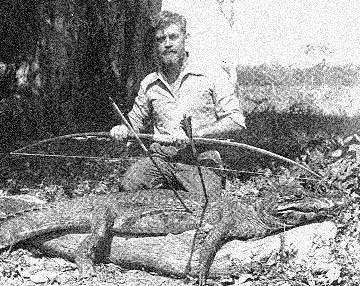 |
Tiger-Man
|
by Cliff Huntington
My interest in the Tiger-Man was spawned about 1961 when I purchased a
used book for ten cents with the intriguing title, "Tigrero."
The book chronicles one of this century's greatest adventurers, Sasha Siemel,
explorer, jungle guide, prospector, soldier of fortune, photographer, author,
master of six languages and tigre hunter. Tiger-Man is best known for his
skill and daring with a spear in dispatching Brazilian jaguars or tigres,
powerful cats weighing up to 350 pounds and he thrilled thousands of people
with his incredible stories and motion pictures lecturing in the United
States and Europe during the forties and fifties. One of my most prized
pieces is an autographed flyer announcing his return to the lecture tour
in the late fifties.
In "Tigrero" Sasha gives scant attention to archery, but one
photo of him posed with a jacare, or marsh crocodile taken with
bow and arrow hints of a deeper involvement. The bow and arrows are the
give-away. On close examination of the bow, we find not the primitive sort
you would expect in the wilds of Brazil, but a powerful appearing weapon
one more associates with Art Young, Erle Stanley Gardner or Dr. Robert
Elmer. The long bow looks to be set back in the handle indicating a spliced
billet, probably of yew. The arrows are nice looking, crown dipped, crested
with what appears to be parabolic grey barred turkey fletch. Not your ordinary
Brazilian bow and arrow but archery tackle with a distinctive American
influence. A letter published in the December, 1937 Ye Sylvan Archer mentions
a yew bow given Sasha by Bob Faas. It's a good chance this is the bow in
the photo.
Knowing the interest archers have in adventure, it's easy to figure how
Dr. Robert Elmer became acquainted with the Tiger-Man during one of his
lecture tours. Dr. Elmer is the man responsible for introducing Sasha Siemel
to American archery and gave him his first lessons in proper, modern shooting
techniques and skill. He also put Sasha in touch with Art Young and the
two would develop a close life-long friendship. The two had much in common
and George Brommers put it well, "Not so much in manners, Art was
more reserved, in fact, quite shy on occasions. But he had the same genuineness,
understanding and simple courtesy and sincerity that characterizes Sasha
Siemel. To have been in the presence of either for as much as five minutes
is to feel that you have known them for years. Instinctively you felt in
both cases that these men really liked you as you liked and respected them.
And both of them compelled respect. Gentlemen do."
Sasha would become well known within the archery community during the thirties,
forties and fifties and his visits to the United States provided opportunity
to spend time shooting with Erle Stanley Gardner, George Brommers, Ken
and Walt Wilhelm and others. He enjoyed his membership in the Lower Bracket
boys and never passed a chance to needle his friend Gardner, "I have
not forgotten that I am titular head of the Lower Bracket Boys, and I can
assure you that never was a distinction more worthily bestowed. From the
last issue of Ye Sylvan Archer I learn that my colleague, Erle Stanley
Gardner, has once more distinguished himself by missing the moose. He is
a wonderful marksman, Erle is, as long as he isn't shooting at anything."
or the Wilhem brothers, "P. S. What got into that guy Ken Wilhelm?
Last I heard of him he and his brother Walt had the presumption to challenge
me for the world's basement championship. I showed the two upstarts where
to head in."
Tiger-man accounted for over 270 jaguars during his career, taken with
rifle, bayonet, spear and bow. He came to prefer the combination of bow
and spear over the rifle, as the following comments suggest, "It is
only logical and natural that I should. The spear is a primitive weapon,
so is the bow. While I would not want to say that hunting big cats with
a rifle can not be plenty dangerous and exciting under all circumstances,
particularly so in our Matto Grosso jungles, where vision is extremely
limited, it seems to me that the bow complements the spear. If I now had
any use for a shield besides, I should be perfectly equipped."
While lecturing at the University Club in Philadelphia in 1936 Sasha would
meet Edith Bray. Edith, a mere eighteen years of age, became so impressed
with Sasha that she convinced her parents to give permission to join Sasha
in the Matto Gross on a jaguar hunt. Helen Post accompanied her as chaperone
and the two women accounted for three jaguars, a mountain lion, marsh deer,
tapir and much small game. During this hunt Sasha's pistol would accidently
discharge as he fought a jaguar with his spear and inflict a grievous wound
to his leg. The two young ladies and some of Sasha's native helpers would
require two weeks by packhorse, oxcart and dugout canoe getting him to
a hospital, barely beating deadly gangrene. Edith would make another trip
to the Matto Grosso as Sasha's girl photographer and eventually convince
Sasha that their 28 years age difference shouldn't be a factor. They were
married in 1940.
Edith would write and publish her account of their life together in the
wilds of the Matto Grosso in "Jungle Wife." She became quite
skilled with the bow and later joined a select group of archers who have
taken the mighty tigre with bow and arrow. Her bow? A fifty pound yew made
by Dr. Klopsteg and given the Siemels as a wedding present.
